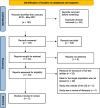Prescription Stimulant Misuse Among Nursing Students: A Systematic Review
- PMID: 37669341
- PMCID: PMC10510837
- DOI: 10.1097/JAN.0000000000000539
Prescription Stimulant Misuse Among Nursing Students: A Systematic Review
Abstract
Nonmedical prescription stimulants are used to reduce symptoms of inattention, impulsivity, and hyperactivity in children and adults with attention-deficit hyperactivity/disorder. They are Schedule II controlled substances because of their high potential for dependence, and individuals who misuse them without a valid prescription are subject to criminal charges. Stimulant medications are also associated with common side effects (e.g., insomnia) as well as more serious but less common side effects (e.g., arrhythmias). Despite the potential health and legal consequences, misuse of prescription stimulants has become a public health crisis on college campuses in the United States. Neurocognitive enhancement is the primary reason that college students report misusing prescription stimulants, despite no enhancement of cognitive functioning when taken by healthy adults. Nursing students may be at risk for misuse because of their high levels of academic and clinical demands and because many start misusing in nursing school. Following the Preferred Reporting Items for Systematic Reviews and Meta-Analyses guidelines, the databases PubMed, Science Direct, EBSCOhost, and Academic OneFile were systematically searched to investigate the (a) percentage of prescription stimulant misuse studies that have included nursing students, (b) prevalence of prescription stimulant misuse among nursing students, (c) motivations for prescription stimulant misuse among nursing students, and (d) demographic factors associated with increased use among nursing students. Results revealed that of the 197 studies conducted within the past decade (2010-2021), only 1.02% (two) included nursing students. Future studies must investigate the prevalence and nature of prescription stimulant misuse among nursing students.
Copyright © 2023 The Authors. Published by Wolters Kluwer Health, Inc.
Conflict of interest statement
The authors report no conflicts of interest. The authors alone are responsible for the content and writing of the article.
Similar articles
-
Collegiate misuse of prescription stimulants: examining differences in self-worth.Subst Use Misuse. 2015 Feb;50(3):358-65. doi: 10.3109/10826084.2014.980956. Epub 2014 Dec 4. Subst Use Misuse. 2015. PMID: 25474729
-
Prescription Stimulant Misuse and ADHD Symptomatology Among College Students in Iceland.J Atten Disord. 2020 Feb;24(3):384-401. doi: 10.1177/1087054716684379. Epub 2016 Dec 25. J Atten Disord. 2020. PMID: 28013572
-
Misuse of stimulant medication among college students: a comprehensive review and meta-analysis.Clin Child Fam Psychol Rev. 2015 Mar;18(1):50-76. doi: 10.1007/s10567-014-0177-z. Clin Child Fam Psychol Rev. 2015. PMID: 25575768 Review.
-
Neuropsychological functioning in college students who misuse prescription stimulants.Am J Addict. 2017 Jun;26(4):379-387. doi: 10.1111/ajad.12551. Am J Addict. 2017. PMID: 28494131 Free PMC article.
-
Prescription Stimulants: From Cognitive Enhancement to Misuse.Pediatr Clin North Am. 2019 Dec;66(6):1109-1120. doi: 10.1016/j.pcl.2019.08.006. Pediatr Clin North Am. 2019. PMID: 31679601 Review.
Cited by
-
The Awareness of Methylphenidate and Its Use: Experiences and Perceptions of Medical Students.Cureus. 2024 Nov 23;16(11):e74317. doi: 10.7759/cureus.74317. eCollection 2024 Nov. Cureus. 2024. PMID: 39717319 Free PMC article.
-
Adverse Childhood Experiences and Prescription Stimulant Use in Adults: A Systematic Review.Pharmacy (Basel). 2024 Mar 21;12(2):52. doi: 10.3390/pharmacy12020052. Pharmacy (Basel). 2024. PMID: 38525732 Free PMC article. Review.
References
-
- Adler C. J. Dobney K. Weyrich L. S. Kaidonis J. Walker A. W. Haak W. Bradshaw C. J. Townsend G. Sołtysiak A. Alt K. W. Parkhill J., & Cooper A. (2013). Sequencing ancient calcified dental plaque shows changes in oral microbiota with dietary shifts of the neolithic and industrial revolutions. Nature Genetics, 45(4), 450–455e1. 10.1038/ng.2536 - DOI - PMC - PubMed
-
- A'see K. M., & Cantey K. B. (2019). Nonmedical use of prescription stimulants in dental hygiene programs: Guidelines for prevention strategies. Journal of Dental Hygiene, 93(2), 23–26. - PubMed
Publication types
MeSH terms
Substances
LinkOut - more resources
Full Text Sources
Medical
Miscellaneous

